

Team Development. Allan Drexler and David Sibbet have refined a comprehensive model of team performance, (Drexler/Sibbet Team Performance™ Model), that shows the predictable stages involved in both creating and sustaining teams.
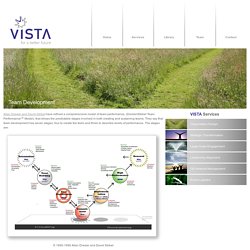
They say that team development has seven stages, four to create the team and three to describe levels of performance. The stages are: © 1990-1999 Allan Drexler and David Sibbet Orientation - WHY am I here? When teams are forming everyone wonders WHY they are here, what their potential fit is and whether others will accept them. We have all experienced the 'other in us'. The purpose of conceptual models of this kind is to make it possible for people to have constructive dialogues with each other about where THEY see their own organisations, in order to come to some common understandings that can serve as the basis of important decisions.
Change + Transform. Team Performance. Groups and Society. Personality Types Under Stress. Personality Types Under Stress - INTP, INTJ, INFP, INFJ INTPs lack follow-through and this can isolate their ideas from practical examination.
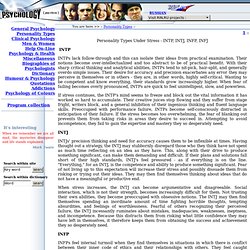
Their notions become over-intellectualized and too abstract to be of practical benefit. With their sharp critical thinking and analytical abilities, INTPs tend to nit-pick, hair-split, and generally overdo simple issues. Their desire for accuracy and precision exacerbates any error they may perceive in themselves or in others - they are, in other words, highly self-critical. Wanting to be competent and know everything, their standards grow increasingly higher. If stress continues, the INTP's mind seems to freeze and block out the vital information it has worked so hard to accumulate. INTJs' precision thinking and need for accuracy causes them to be inflexible at times. When stress increases, the INTJ can become argumentative and disagreeable.
As with all NFs, the INFP will feel lost and perplexed at stressful times.
Cambridge Ideas - The Boat Race: A Perfect Crew? Group development. The goal of most research on group development is to learn why and how small groups change over time.

To do this, researchers examine patterns of change and continuity in groups over time. Aspects of a group that might be studied include the quality of the output produced by a group, the type and frequency of its activities, its cohesiveness, the existence of group conflict. A number of theoretical models have been developed to explain how certain groups change over time. Listed below are some of the most common models.
Psychology of Teams. Dream Teams. A stellar team is greater than the sum of its individuals' ideas—from the Beatles to Google to Regis and Kelly, the world teems with proof of this exponential synergy.

Ultimately, the magic behind innovative duos comes down to a few key ingredients: The pair usually has a shared vision, and complementary talents and temperaments. "If one scientist is theoretical and the other is a great lab administrator, they can be very productive," says Vera John-Steiner, a University of New Mexico professor and the author of Creative Collaboration . A careful balance of encouragement and criticism enables creative partners to bring out the best in each other. In the beginning stages of a project, John-Steiner says, the ideas need to flow freely, but great duos must help each other find the "rough diamond" in the brainstorm. Teams that work and sleep together may have a double-edged partnership.
Venturi, for his part, says that the two work in parallel. The Five Stages of Project Team Development. May 8, 2010 | Author: PM Hut | Filed under: Team Building The Five Stages of Project Team Development By Gina Abudi Every team goes through the five stages of team development.
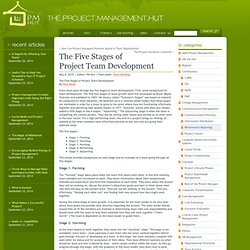
First, some background on team development. The first four stages of team growth were first developed by Bruce Wayne Tuckman and published in 1965. His theory, called “Tuckman’s Stages” was based on research he conducted on team dynamics. The five stages: Stage 1: FormingStage 2: StormingStage 3: NormingStage 4: PerformingStage 5: Adjourning This article provides background on each stage and an example of a team going through all five stages. Stage 1: Forming The “forming” stage takes place when the team first meets each other. HANDOUT_-_Tuckmans_Team_Development_Model.pdf.
Tuckman's stages of group development. The Forming – Storming – Norming – Performing model of group development was first proposed by Bruce Tuckman in 1965, who maintained that these phases are all necessary and inevitable in order for the team to grow, to face up to challenges, to tackle problems, to find solutions, to plan work, and to deliver results.
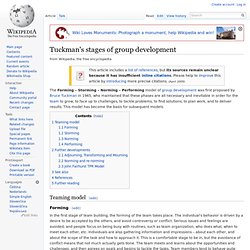
This model has become the basis for subsequent models. Teaming model[edit] Forming[edit] In the first stage of team building, the forming of the team takes place. The individual's behavior is driven by a desire to be accepted by the others, and avoid controversy or conflict. The forming stage of any team is important because the members of the team get to know one another, exchange some personal information, and make new friends. Storming[edit] In the storming stage, enough initial trust has been developed between team members that they start to feel comfortable expressing discontent and challenging others' opinions.
Norming[edit] Performing[edit] Further developments[edit] Maslow’s Hierarchy of Needs. Summary: Maslow’s Hierarchy of Needs (often represented as a pyramid with five levels of needs) is a motivational theory in psychology that argues that while people aim to meet basic needs, they seek to meet successively higher needs in the form of a pyramid.
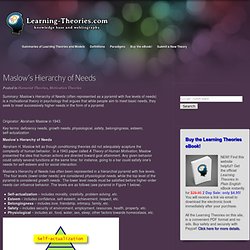
Originator: Abraham Maslow in 1943. Mc_team_development.pdf. Team Work. Effective Team Work & Collaboration. MIT management professor Tom Malone on collective intelligence and the “genetic” structure of groups. Do groups have genetic structures?

If so, can they be modified? Those are two central questions for Thomas Malone, a professor of management and an expert in organizational structure and group intelligence at MIT’s Sloan School of Management. In a talk this week at IBM’s Center for Social Software, Malone explained the insights he’s gained through his research and as the director of the MIT Center for Collective Intelligence, which he launched in 2006 in part to determine how collective intelligence might be harnessed to tackle problems — climate change, poverty, crime — that are generally too complex to be solved by any one expert or group. Katzenbach & Smith (1993) The discipline of teams, HBR. Innovation. Characteristics. Teamwork- very funny video. Teamwork funny.